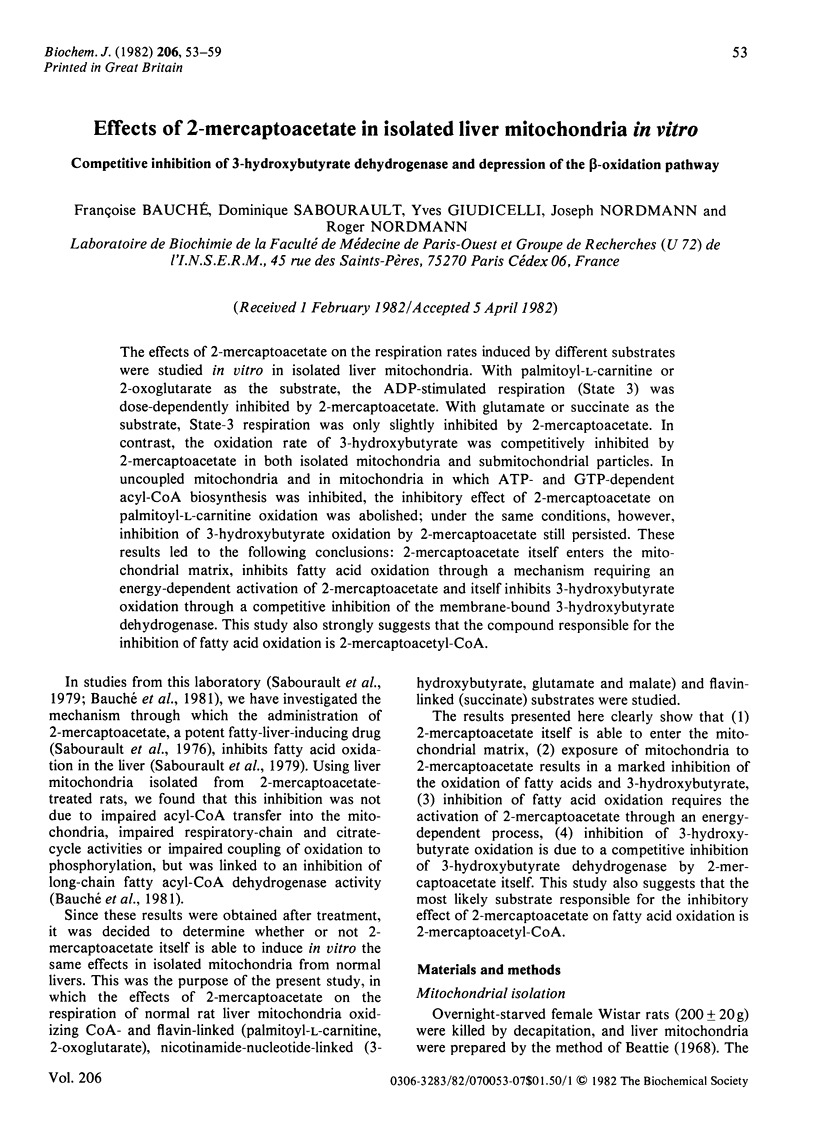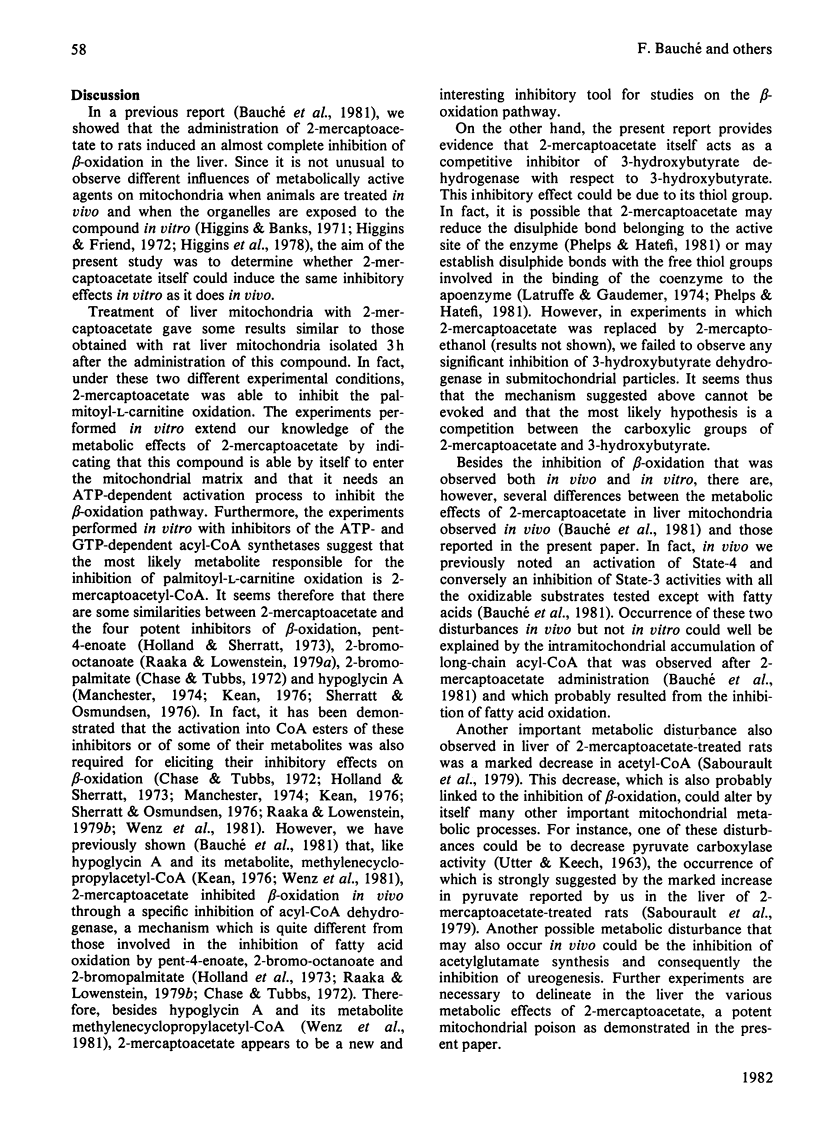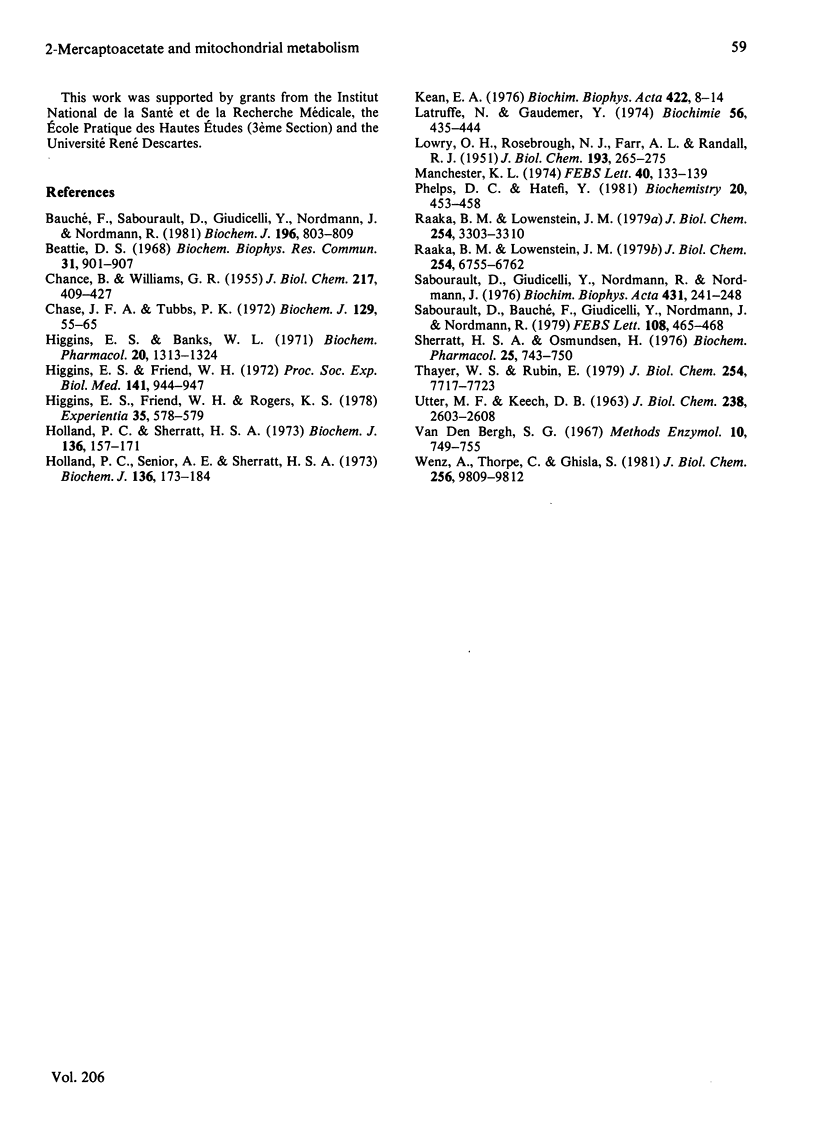Abstract
The effects of 2-mercaptoacetate on the respiration rates induced by different substrates were studied in vitro in isolated liver mitochondria. With palmitoyl-L-carnitine or 2-oxoglutarate as the substrate, the ADP-stimulated respiration (State 3) was dose-dependently inhibited by 2-mercaptoacetate. with glutamate or succinate as the substrate. State-3 respiration was only slightly inhibited by 2-mercaptoacetate. In contrast, the oxidation rate of 3-hydroxybutyrate was competitively inhibited by 2-mercaptoacetate in both isolated mitochondria and submitochondrial particles. In uncoupled mitochondria and in mitochondria in which ATP- and GTP-dependent acyl-CoA biosynthesis was inhibited, the inhibitory effect of 2-mercaptoacetate on palmitoyl-L-carnitine oxidation was abolished; under the same conditions, however, inhibition of 3-hydroxybutyrate oxidation by 2-mercaptoacetate still persisted. These results led to the following conclusions: 2-mercaptoacetate itself enters the mitochondrial matrix, inhibits fatty acid oxidation through a mechanism requiring an energy-dependent activation of 2-mercaptoacetate and itself inhibits 3-hydroxybutyrate oxidation through a competitive inhibition of the membrane-bound 3-hydroxybutyrate dehydrogenase. This study also strongly suggests that the compound responsible for the inhibition of fatty acid oxidation is 2-mercaptoacetyl-CoA.
Full text
PDF






Selected References
These references are in PubMed. This may not be the complete list of references from this article.
- Bauché F., Sabourault D., Giudicelli Y., Nordmann J., Nordmann R. 2-Mercaptoacetate administration depresses the beta-oxidation pathway through an inhibition of long-chain acyl-CoA dehydrogenase activity. Biochem J. 1981 Jun 15;196(3):803–809. doi: 10.1042/bj1960803. [DOI] [PMC free article] [PubMed] [Google Scholar]
- Beattie D. S. Enzyme localization in the inner and outer membranes of rat liver mitochondria. Biochem Biophys Res Commun. 1968 Jun 28;31(6):901–907. doi: 10.1016/0006-291x(68)90537-8. [DOI] [PubMed] [Google Scholar]
- CHANCE B., WILLIAMS G. R. Respiratory enzymes in oxidative phosphorylation. III. The steady state. J Biol Chem. 1955 Nov;217(1):409–427. [PubMed] [Google Scholar]
- Chase J. F., Tubbs P. K. Specific inhibition of mitochondrial fatty acid oxidation by 2-bromopalmitate and its coenzyme A and carnitine esters. Biochem J. 1972 Aug;129(1):55–65. doi: 10.1042/bj1290055. [DOI] [PMC free article] [PubMed] [Google Scholar]
- Higgins E. S., Friend W. H., Rogers K. S. Depression by ethionine of phosphorylating oxidation in hepatic mitochondria. Experientia. 1978 May 15;34(5):578–579. doi: 10.1007/BF01936969. [DOI] [PubMed] [Google Scholar]
- Higgins E. S., Friend W. H. Time course of the acute alcoholic fatty liver and concomitant mitochondrial function in fasted rats. Proc Soc Exp Biol Med. 1972 Dec;141(3):944–947. doi: 10.3181/00379727-141-36907. [DOI] [PubMed] [Google Scholar]
- Ho B. T., Estevez V., Fritchie G. E., Tansey L. W., Idänpän-Heikkilä J., McIsaac W. M. Metabolism of harmaline in rats. Biochem Pharmacol. 1971 Jun;20(6):1313–1319. doi: 10.1016/0006-2952(71)90363-7. [DOI] [PubMed] [Google Scholar]
- Holland P. C., Senior A. E., Sherratt H. S. Biochemical effects of the hypoglycaemic compound pent-4-enoic acid and related non-hypoglycaemic fatty acids. Effects of their coenzyme A esters on enzymes of fatty acid oxidation. Biochem J. 1973 Sep;136(1):173–184. doi: 10.1042/bj1360173. [DOI] [PMC free article] [PubMed] [Google Scholar]
- Holland P. C., Sherratt H. S. Biochemical effects of the hypoglycaemic compound pent-4-enoic acid and related non-hypoglycaemic fatty acids. Effects of the free acids and their carnitine esters on coenzyme A-dependent oxidations in rat liver mitochondria. Biochem J. 1973 Sep;136(1):157–171. doi: 10.1042/bj1360157. [DOI] [PMC free article] [PubMed] [Google Scholar]
- Kean E. A. Selective inhibition of acyl-CoA dehydrogenases by a metabolite of hypoglycin. Biochim Biophys Acta. 1976 Jan 23;422(1):8–14. doi: 10.1016/0005-2744(76)90003-6. [DOI] [PubMed] [Google Scholar]
- Latruffe N., Gaudemer Y. Propriétés et mécanisme cinétique de la D(minus)beta-hydroxybutyrique déshydrogénase de particules sous-mitochondriales de foie de rat. Effets comparés de différents agents thiols. Biochimie. 1974;56(3):435–444. doi: 10.1016/s0300-9084(74)80152-5. [DOI] [PubMed] [Google Scholar]
- Phelps D. C., Hatefi Y. Inhibition of D(--)-beta-hydroxybutyrate dehydrogenase by modifiers of disulfides, thiols, and vicinal dithiols. Biochemistry. 1981 Feb 3;20(3):453–458. doi: 10.1021/bi00506a001. [DOI] [PubMed] [Google Scholar]
- Raaka B. M., Lowenstein J. M. Inhibition of fatty acid oxidation by 2-bromooctanoate. Evidence for the enzymatic formation of 2-bromo-3-ketooctanoyl coenzyme A and the inhibition of 3-ketothiolase. J Biol Chem. 1979 Jul 25;254(14):6755–6762. [PubMed] [Google Scholar]
- Raaka B. M., Lowenstein J. M. Inhibition of fatty acid oxidation by 2-bromooctanoate. Including effects of bromooctanoate on ketogenesis and gluconeogenesis. J Biol Chem. 1979 May 10;254(9):3303–3310. [PubMed] [Google Scholar]
- Sabourault D., Bauché F., Giudicelli Y., Nordmann J., Nordmann R. Inhibitory effect of 2-mercaptoacetate on fatty acid oxidation in the liver. FEBS Lett. 1979 Dec 15;108(2):465–468. doi: 10.1016/0014-5793(79)80589-x. [DOI] [PubMed] [Google Scholar]
- Sabourault D., Giudicelli Y., Nordmann R., Nordmann J. Is fatty liver induction a general feature of the administration of foreign sulfhydryl compounds? Biochim Biophys Acta. 1976 May 27;431(2):241–248. doi: 10.1016/0005-2760(76)90144-2. [DOI] [PubMed] [Google Scholar]
- Stanley H., Sherratt A., Osmundsen H. On the mechanisms of some pharmacological actions of the hypoglycaemic toxins hypoglycin and pent-4-enoic acid. A way out of the present confusion. Biochem Pharmacol. 1976 Apr 1;25(7):743–750. doi: 10.1016/0006-2952(76)90139-8. [DOI] [PubMed] [Google Scholar]
- Thayer W. S., Rubin E. Effects of chronic ethanol intoxication on oxidative phosphorylation in rat liver submitochondrial particles. J Biol Chem. 1979 Aug 25;254(16):7717–7723. [PubMed] [Google Scholar]
- UTTER M. F., KEECH D. B. PYRUVATE CARBOXYLASE. I. NATURE OF THE REACTION. J Biol Chem. 1963 Aug;238:2603–2608. [PubMed] [Google Scholar]
- Wenz A., Thorpe C., Ghisla S. Inactivation of general acyl-CoA dehydrogenase from pig kidney by a metabolite of hypoglycin A. J Biol Chem. 1981 Oct 10;256(19):9809–9812. [PubMed] [Google Scholar]


